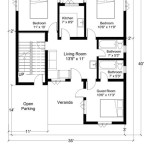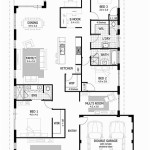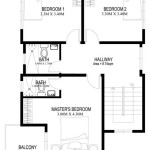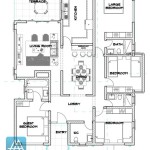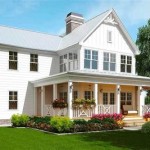2 Bedroom Floor Plan With Dimensions In Millimeters
The design of a 2-bedroom floor plan is a common requirement in residential architecture, fulfilling a wide range of housing needs, from small families to individuals desiring a guest room or home office. A critical aspect of these floor plans is the precise allocation of space, which is effectively conveyed through dimensions in millimeters (mm). This level of detail allows for accurate planning, minimizing errors during construction and ensuring that furniture and appliances fit appropriately. Understanding and interpreting these dimensions is essential for architects, builders, and homeowners alike.
Accurate dimensioning in millimeters provides a significant advantage over measurements in feet or inches, particularly when dealing with detailed interior layouts. The smaller unit allows for greater precision, reducing the likelihood of rounding errors that can accumulate across larger spaces. This is particularly important in areas such as kitchens and bathrooms, where appliances and fixtures often have specific size requirements. Furthermore, the adoption of metric units facilitates easier communication and collaboration between international teams of designers and builders.
This article will explore key aspects of 2-bedroom floor plans, with a particular focus on the importance of dimensions provided in millimeters. It will address critical components, layout considerations, and relevant details to ensure a comprehensive understanding of designing and interpreting these types of plans.
Key Point 1: Essential Components of a 2-Bedroom Floor Plan
A well-designed 2-bedroom floor plan incorporates several essential components that contribute to its overall functionality and comfort. Each of these components must be carefully considered to ensure efficient use of space and to meet the specific needs of the occupants. The following are crucial spaces commonly observed within such floor plans:
Bedrooms: The primary purpose of a 2-bedroom apartment or house is to provide two sleeping spaces. The master bedroom is typically larger than the second bedroom and often includes an en-suite bathroom or a walk-in closet. Dimensions for the master bedroom commonly range from 3600 mm x 4200 mm to 4500 mm x 5100 mm, depending on the overall size and layout of the property. The second bedroom, often used as a guest room or a child's room, might measure from 3000 mm x 3600 mm to 3600 mm x 4200 mm. Accurate dimensions are critical here to ensure sufficient space for a bed, wardrobe, and possibly a desk or other furniture.
Bathrooms: Bathrooms are essential and typically include a toilet, sink, and shower or bathtub. Dimensions significantly influence the functionality and usability of this space. A master bathroom may measure approximately 2100 mm x 2700 mm, providing ample room for movement and the incorporation of larger fixtures. A second bathroom, or a shared bathroom, might be smaller, around 1800 mm x 2400 mm. These dimensions need to accommodate the clearances required for comfortable use of each fixture.
Living Area: The living area forms the central gathering space within the home and should be spacious and adaptable. Dimensions for a living area can start at 3900 mm x 4800 mm and extend to 5400 mm x 6600 mm or larger, depending on the overall design of the property. This space needs to be adequate to comfortably accommodate seating arrangements, entertainment units, and possibly a dining area.
Kitchen: The kitchen is a heavily used area requiring careful planning to ensure efficient workflow. Dimensions for a kitchen can vary significantly depending on whether it is an open-plan design integrated with the living area or a separate room. A typical kitchen might measure between 2400 mm x 3000 mm and 3000 mm x 3600 mm. These dimensions must accommodate countertops, appliances (such as refrigerators, ovens, and dishwashers), and sufficient workspace for food preparation.
Dining Area: Often integrated with the living area or kitchen, the dining area requires careful consideration of dimensions to ensure comfortable seating and circulation space. A dedicated dining area might measure from 2400 mm x 3000 mm to 3000 mm x 3600 mm, accommodating a dining table and chairs. If integrated with the living area, sufficient space must be allocated to avoid overcrowding.
Entryway/Hallway: The entryway and hallway provide access to different rooms within the 2-bedroom floor plan. Hallway widths should ideally be at least 1200 mm wide to allow for comfortable movement and accessibility. The entryway should be large enough to accommodate shoes, coats, and possibly a small table or bench. It's critical to consider the dimensions of furniture and appliances that may need to be moved through these spaces during the initial planning phase.
Storage: Adequate storage is crucial in any living space. This may include closets in each bedroom, linen closets, and possibly additional storage areas. Closet depths typically range from 600 mm to 750 mm, providing sufficient space for hanging clothes or storing other items. Linen closets should have shelves spaced appropriately to accommodate towels and bedding. The inclusion of storage dimensions within the floor plan is often overlooked but is essential for the long-term utility of the design.
Key Point 2: Layout Considerations and Dimensioning Conventions
Successful 2-bedroom floor plan design depends on careful consideration of layout and adherence to established dimensioning conventions. The placement of rooms, the flow of traffic, and the accurate communication of dimensions all contribute to a functional and comfortable living space.
Room Placement: The placement of rooms within the floor plan significantly impacts the overall usability and feel of the space. Bedrooms are typically placed away from high-traffic areas to provide privacy and quiet. The living area and kitchen are often located near the entrance for easy access and social interaction. Bathrooms should be conveniently located near bedrooms, particularly the master bedroom. Consideration must be given to factors such as natural light, views, and noise levels when determining the placement of each room.
Traffic Flow: Efficient traffic flow is essential to avoid congestion and ensure ease of movement throughout the floor plan. Hallways should be wide enough to accommodate multiple people passing each other comfortably. Doorways should be strategically placed to minimize obstruction and maximize usable wall space. The layout should minimize the need to walk through one room to access another, whenever possible.
Dimensioning Conventions: Accurate and consistent dimensioning is crucial for clear communication and successful construction. Dimensions are typically provided in millimeters, indicating the length and width of each room. Wall thicknesses, door and window openings, and the placement of fixtures and appliances should also be clearly dimensioned. Dimensions are often indicated using extension lines, dimension lines, and arrowheads. The dimension value is placed above the dimension line or within a break in the line. It is essential to adhere to established architectural drafting standards to ensure that the dimensions are easily understood and interpreted.
Overall Dimensions: The overall dimensions of the floor plan should be clearly indicated, providing the total length and width of the building or apartment. This allows for accurate calculation of square footage and enables builders to properly position the structure on the site. In addition to the overall dimensions, the dimensions of individual walls, windows, and doors should also be provided.
Internal Wall Dimensions: The dimensions of internal walls affect the size of rooms and the overall space allocation. Dimensions should take into account the thickness of the wall, as well as the finish material applied to the wall. This is particularly important in areas such as bathrooms and kitchens where tile or other wall coverings may add to the overall wall thickness.
Accessibility Considerations: Accessible design is becoming increasingly important in residential architecture. This involves incorporating features that make the space usable for people with disabilities, such as wider doorways, accessible bathroom fixtures, and ramps. Dimensions should be carefully considered to ensure that these features meet the required accessibility standards.
Key Point 3: Specific Dimensioning Details and Considerations
Beyond general room dimensions, several specific details require careful dimensioning to ensure a successful 2-bedroom floor plan. These details range from door and window sizes to the placement of electrical outlets and the dimensions of built-in furniture.
Door and Window Dimensions: Door and window dimensions are critical for ensuring proper functionality and aesthetics. Door widths should be sufficient to allow for comfortable passage, typically at least 800 mm wide. Door height is generally around 2100 mm. Window dimensions affect the amount of natural light entering the room and should be sized appropriately for the room's size and function. Window sill heights, head heights, and frame thicknesses should also be accurately dimensioned.
Electrical Outlet and Switch Placement: The placement of electrical outlets and switches is crucial for convenience and safety. Outlets should be placed strategically to avoid the need for extension cords and to provide power where it is needed. Switch heights should be consistent throughout the floor plan, typically around 1200 mm above the floor. The dimensions of the electrical panel and its location should also be indicated on the floor plan.
Plumbing Fixture Placement: The placement of plumbing fixtures, such as toilets, sinks, and showers, is critical for bathroom functionality. The dimensions of each fixture, as well as the clearances required around them, should be carefully considered. The location of water supply lines and drainpipes should also be indicated on the floor plan.
Kitchen Appliance Dimensions: The dimensions of kitchen appliances, such as refrigerators, ovens, and dishwashers, are essential for ensuring that they fit properly within the kitchen layout. Countertop heights, cabinet depths, and backsplash dimensions should also be accurately dimensioned. Sufficient clearance space should be provided around each appliance to allow for comfortable use and maintenance.
Built-in Furniture Dimensions: If the floor plan includes built-in furniture, such as bookshelves or cabinets, the dimensions of these elements should be clearly indicated. This allows for accurate construction and ensures that the furniture fits seamlessly within the space. The materials and finishes used for the built-in furniture should also be specified.
Ceiling Heights: Ceiling heights significantly affect the perceived spaciousness of a room. Standard ceiling heights are typically around 2400 mm to 2700 mm. However, higher ceilings can create a more open and airy feel. The floor plan should indicate the ceiling height in each room, as well as any variations in ceiling height.
Wall Thickness: The dimensions of walls, both internal and external, can significantly impact the overall dimensions of rooms and usable space. Common internal wall thicknesses are 100mm to 150mm, which includes finishes like plasterboard. External walls are often thicker, ranging from 200mm to 300mm, or even more depending on the construction material and insulation requirements. These thicknesses should be accurately shown on the plan.
By considering these specific dimensioning details, architects and builders can create 2-bedroom floor plans that are both functional and aesthetically pleasing.

12 Examples Of Floor Plans With Dimensions

Wanda Simple 2 Bedroom House With Fire Wall Pinoy Eplans

The Best 2 Bedroom House Plans Maker Templates

Modern Style House Plan 2 Beds 1 Baths 1397 Sq Ft 497 59 Dreamhomesource Com

Floor Plan With Dimensions Guide To Drawings

Mm Available Studio One Two And Three Bedroom Apartments In Oakland Ca The Skylyne At Temescal

Mm 3071 House Plan Two Story Modern Multi Generational Home Design

12 Examples Of Floor Plans With Dimensions

Small House Plan Ch225

Modern Plan 1 170 Square Feet 2 Bedrooms Bathrooms Floor 1462 00125 America S Best House Plans
Related Posts

